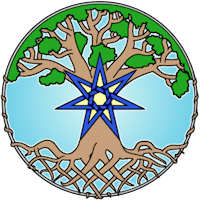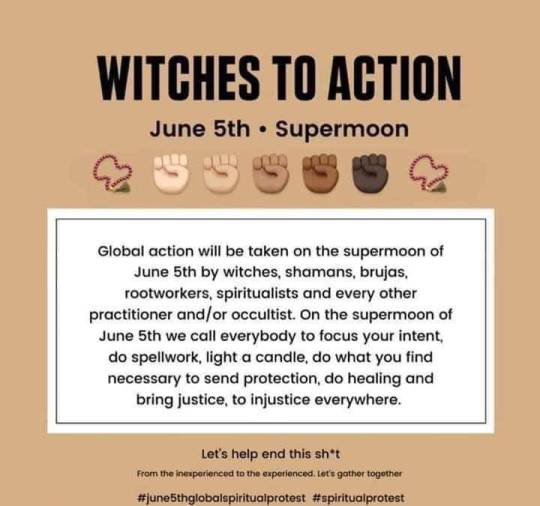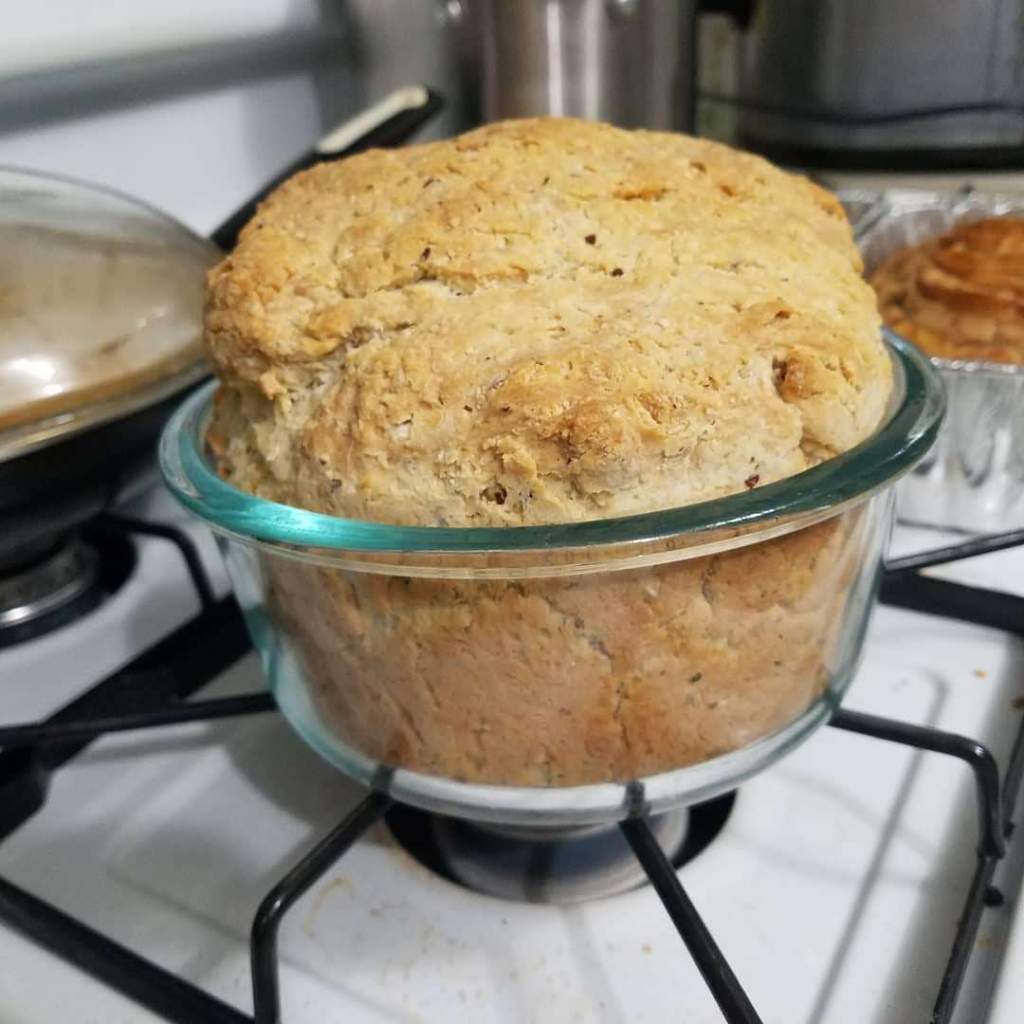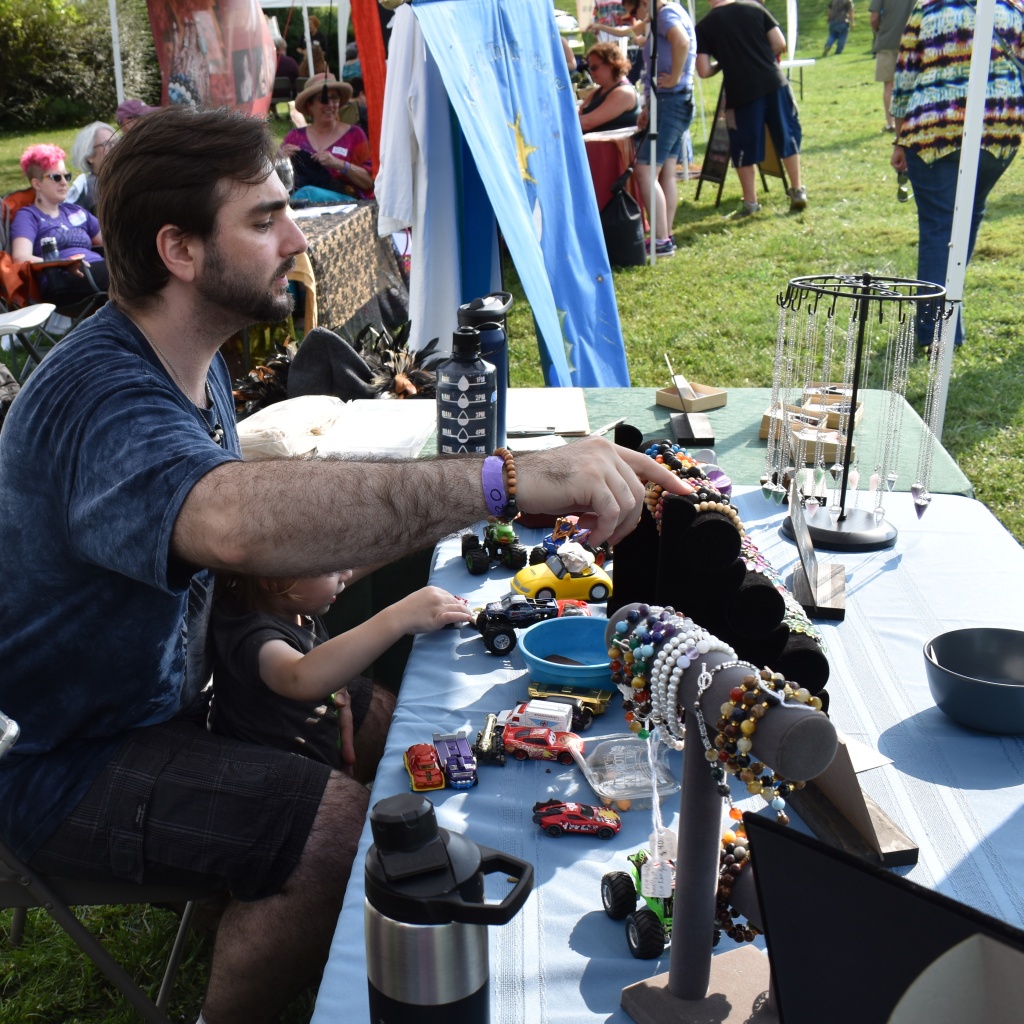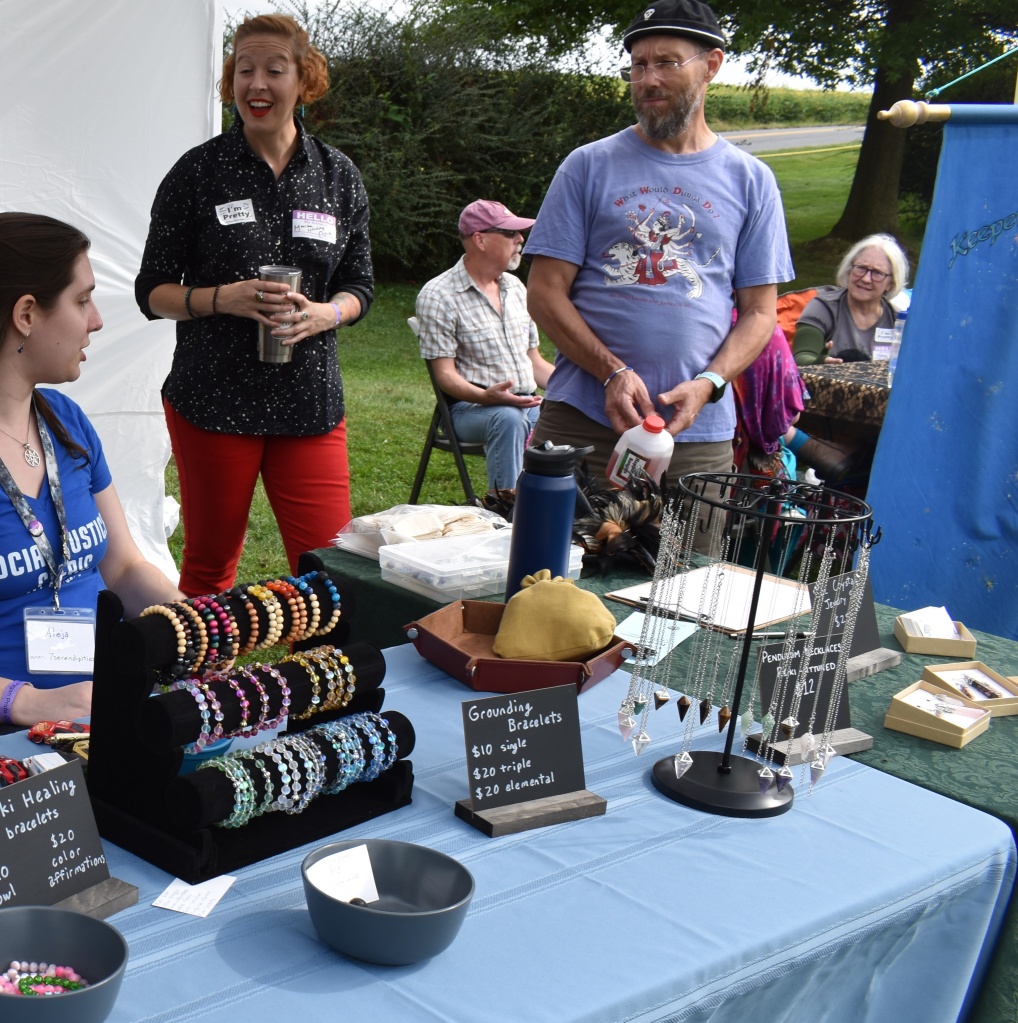This was our first time at Mystic South, and I’m so glad I applied (last minute) to present, because it was a wonderful experience! I also want to share that they comped my registration fee, which was unexpected and a very nice change! I don’t think any of the large gatherings in the DC/MD/VA area do that. It made the conference really affordable, despite three nights in a hotel and a ten hour drive each way. I do think I’ll plan to present again next year – the only question is on what topic! The 90 minute blocks for 60 minute presentations was a good set up, because it gave us time to go over a little, and to run up to our rooms or peruse vendors between blocks. I was very happy with the diversity of presentations, both in topics (folk magic or chaos magic, astrology or Konmari), and in the presenters (several women of color, quite a few queer folks). We were happy to see some people we already new (Ivo Dominguez Jr, Michael G. Smith, Byron Ballard), to meet people we only know online (John Beckett, Ryan Denison), and to make new connections!
Read on for snippets from some of the workshops I attended!
Byron Ballard – Finding the Other Realms under Suburbia
I’m a fan of Byron’s workshops on the Fair Folk in general, and this one was not disappointing. She talked of talking to spirits – even types we might not expect – in urban places, and how urban witches can draw upon the energy of local flows for power: the flows of water pipes, of electricity, of traffic. DC has sacred geometry built into its layout, but other cities have equally powerful layouts of city center and liminal outskirts. Skyscrapers are human-made mountains from which we can gather power and cast workings over all we see. She also discussed using other liminal spaces and movement: riding public transport or crossing a large street on foot, setting an intention and then letting the spell take hold by the time you arrive at your destination, so that the journey is the casting. She reminded us that magic is not just aesthetic but also it’s not just for the highest of purposes: everyone needs to practice their skills to hone them, and those of us who live in cities ought to have a decent spell for finding parking.
Katelyn Willis: Navigating the Ethical Entanglements of Pagan Leadership
This was a presentation of an academic paper that was about half presentation and half open discussion. Willis (they/them) was using three values models: John Beckett’s Four Centers Model (also expanded upon in his 2017 book, The Path of Paganism), Emma Restall Orr’s Four Threads Model from her 2008 book Living with Honour: A Pagan Ethics, and the anthropological Kluckhohn-Strodtbeck Values Orientation Theory Model. Beckett’s Four Centers are: Self, Nature, Deity, and Community. Orr’s Four Threads are Fashion (or aesthetic), Magic, Scholarship, and Nature. Kluckhohn and Strodtbeck theorize that individuals (and groups) have value orientations in each of five areas: time, human nature, relationships with others, relationships with nature, and activity. We discussed each model and then Willis led a discussion through a framework for ethical decision making when pagan leaders are faced with conflicts in their communities. They recommended both Beckett and Orr’s books, and added a third favorite: Katherine McDowell’s Ethics and Professional Practice for Neopagan Clergy.
My Workshop: Seeking the Daughters of Flidais
I expected to have fewer than a dozen attendees, because I was presenting on some pretty obscure Irish goddesses, but I was pleasantly surprised to have closer to two dozen in my audience! Unfortunately I hadn’t prepared quite enough handouts for that many!
My presentation was structured to start with the available lore for each pair of daughters (Bé Chuille and Dinand, Fand and Lí Ban, and Bé Téite and Arden), along with epithets and possible etymologies. I then shared my experiences with each and some UPG. At the end I led a short guided meditation so the attendees could hopefully interact with these deities. We went slightly over time, but luckily there was a half hour break between class blocks!
If you’re interested in my handout (which mostly covers lore) and the meditation, they can be accessed here: Seeking the Daughters of Flidais.
Ivo Dominguez, Jr: The Signs – 12 Styles of Consciousness
This workshop was primarily focused on understanding our natal sun, moon, and rising signs and how to use those to bring ourselves into better alignment. For the sun sign, Ivo explained that this is our source, and if we’re feeling depleted, we need to invigorate our sun. Positive traits of each sign will lean us towards the next sign, and negative traits are when we fall back into the previous sign. (Aquarius is more positive as it leans towards Pisces, and more negative as it falls into Capricorn, for example.) To illustrate that, he provided a handout with a chart that is featured in his recently published astrology book, Practical Astrology for Witches and Pagans. For our moon signs, Ivo suggested that if we’re having difficulty with our internal narrative, we should turn to the elemental siblings of our sign. (Gemini Moons should turn to Libra and Aquarius, for example.) For our rising sign, or Ascendant, Ivo suggested looking at our Descendant as well (the opposite sign) and try to balance the two (for example, Capricorn and Cancer). He described the Ascendant not as the “personality”, because both sun and rising create parts of our personality, but rather as the GUI, the graphical user interface, for this particular lifetime.
Ivo also gave us two insights that in retrospect are sort of well-duh moments. The first: the glyphs of the signs and the planets are sigils and you can and should use them as such: inscribe them on yourself, on candles, incorporate them into workings! The second: a lot of human belief and study and experience has been poured into the 12 signs of the western zodiac, and he believes it’s enough that they’ve become at least egregores and possibly deity-forms, which means we can invoke them directly! I may need to buy his book.
Sangoma: Crossing Lines, Healing our Racial Divide
This was sort of an open discussion of workings we could use to heal ourselves and our society, with frequent anecdotes from Sangoma about her own life as a black Cherokee woman, and founder of a spiritual healing community. It was engrossing and I did not take as many notes as I might otherwise have. I did write down her answer to a very powerful exchange between Sangoma and a white attendee. The attendee had recently learned that some of her ancestors had owned land near where we were in Georgia, and that in addition to that land they had also owned five slaves. She wanted to know what she could do with that knowledge, how she could make up for the trauma her ancestors perpetuated, how she could work with ancestors who had done something like that. Sangoma’s response was concise and actionable: Find out who they were, if you can. Find their descendants, if you can, and help them out. Find out where they were buried, if you can, and give them last rites so that they may go peacefully into the next world. And what about the black nannies who raised your family? Do you send them Christmas cards? Find them and their descendants, too. The only thing you can do is ask the dead for forgiveness, and help the living as best you can.
I did not know prior to attending that she was indigenous – having found out during the presentation, I asked Scott to run up to the room to get tobacco, and I gifted her with it after the workshop, to thank her for doing this work. We talked for a few moments about indigeneity, and she asked about my people and our culture and history. I am very glad to have had the opportunity to learn from this Elder.
Sid Simpson: Color Schemes – Providing a Spiritual and Cultural Concept Framework for Use of Color from the Historic Heathen Era
Sid brought a huge assortment of hands on stuff to toss around while we listened to her presentation, from strands of beads to linen swatches, to works-in-progress of embroidery and card weaving. Her background is in living history and archaeological study, and she’s a member of the SCA in addition to being a practicing Heathen. The main thesis of the presentation was that color didn’t used to symbolize wealth, it WAS wealth, and wealth was worn openly to denote social status. White, black, and red were the most expensive colors at the time, and anyone wearing highly decorated clothing in those colors was probably wealthy and important. Clothing and other items also tell scholars a lot about the tribe or village people were from as well, what kind of trade connections they had and how successful they were. She used King Raedwald from the Sutton Hoo ship burial as her main example throughout the presentation. It was really interesting, and Sid had a good takeaway message for Heathens doing ancestor work: don’t “symbolize” wealth to your ancestors, just show up wearing bright colors and gold jewelry! Show them that you’re being successful and honoring their memories when you ask for help.
John Beckett: Self-Care for Priests and Other Pagan Leaders
Beckett began with a short prayer, and then a three-part definition of “priest”: 1) serves their deities, 2) mediates for their deities, 3) serves their community. It’s a decent definition, and one that does seem to apply to my “priestess-ing” for the Morrigna last fall/winter. My oracular work for Bast and Sekhmet includes the first two but arguably doesn’t serve a community. That’s a very specific type of “priesthood”, though, and that’s why I’m specific when I describe it, calling myself an oracular-priestess-novitiate (novitiate because I’m still in training). On the “Other Pagan Leaders” side of things, I do serve my community but not the deities in my roles as Librarian of The Fellowship Beyond the Star, and as an organizer of Fox and Fungi at the UU Church in Reston. I attended this workshop in large part to be able to bring notes back to my fellow leaders in those two organizations.
Beckett emphasized that priesthood is not a position of authority; it’s a position of service. First to arrive, last to leave, etc. But it’s also important to not become a martyr or to get completely burnt out. When you’re teetering on that edge, Beckett recommends returning to your foundations. Why are you pagan? Why did you become clergy? Something called you – build on that. Know why you do what you do, because that will make it easier to keep going. Take the time to nurture your deity relationships. Beckett is a firm believer that having a daily practice is key.
Boundaries are also very important! People need boundaries and groups need bylaws. Priests need to understand the boundaries of their expertise: we need to know when to make a referral to a pagan-friendly therapist (and I would add: or a lawyer, or a doctor, or a life coach). Sometimes people need pastoral counseling and he’s happy to provide that either in person or through emails, but he only does a few exchanges or meetings before he has to set a boundary and either make a referral or quote his rates as a spiritual advisor. He has a day job and does not have the time or energy to be available to everyone who wants help.
Beckett also stressed accountability, and the need for clergy to have people they can go to for their own pastoral counseling. He turns to his “advanced peers”, like Ivo Dominguez Jr. It’s important within your own group, however, to have people who can tell you when you need to just go home and sleep. It’s also a good idea to keep up with continuing education (both in pastoral counseling and also in pagan theology and your personal paths), and to attend things like retreats and conferences. He also recommends moving in a multiple groups, so that you have diverse support networks in case one group is entirely run down, themselves. Within the groups, it’s a very good idea to train your replacements, and to make the division of duties as clear as possible, so that the group will continue to exist after you leave. I had a lot of thoughts about the groups I’m a part of and the groups I’m helping lead, and some good ideas for ways to improve them.
Also, I bought his book (Paganism in Depth) and had him sign it.
Stephanie Woodfield: Divination Magic with Skulls and Bones
So, I don’t really “do” bones. They aren’t really part of my witchcraft – either practice or aesthetic. But I’ve heard good things about Stephanie Woodfield, and I can’t resist learning a new kind of divination, ever, so I had to attend this. And WOW, was it packed! The front table was just absolutely covered with bones, which she said would be for the hands on portion at the end of class.
The first part of the workshop was mostly on the what and how of bone divination. Woodfield said that a lot of people think what you’re supposed to connect with is the animal the bones belonged to, but that’s not usually the case. (Whoops!) Instead, the animal soul itself is usually either already gone, or leaves once it agrees to be a tool, or becomes a vehicle for the species Oversoul, or that Oversoul becomes a vehicle for connection to the Ancestors. Animal bones are better than human in her experience, even human bones ethically and consensually obtained: humans just seem to have more ideas about how they want their remains to be used or honored than animals do. So when you first acquire bones, Woodfield recommends cleaning them, cleansing them, and then trying to connect with what’s left of the animal’s soul, to figure out if it wants anything and if it’s willing to work with you. Then you can negotiate what kind of work for what kind of offerings, and prepare it to become a vehicle.
Woodfield described four major branches of bone divination: 1) skull divination (often scrying inside the brain cavity), 2) throwing bones (this kind is usually a mix of bones and may include nuts, shells, and metal objects), 3) slaughter bones (one-time use divination from an animal that is eaten), and 4) single animal throwing kits (either from one individual or from one species). She gave lots of examples of each, and I started to get Vibes that I may need to take a closer look at some fox bones I have by accident. So, maybe that’s a thing, now.
At the end of the class she had us all select a bone and then attempt to connect with it. I didn’t get much – I had a sensation of large whiskers and I was pretty sure it was a small herbivore and that it lived near water. It turned out to be a bone from a calf that had lived on a farm near a river. Not as small as I was thinking, but I suppose it must feel small next to its mother! Apparently the poor thing had been caught by coyotes one night, and the bones had been given to Woodfield by her friend who owned the farm.
Amy Blackthorn: Justice Craft of the Wise
I’ve near-missed Amy Blackthorn a couple of times at other events, but she’s the headliner at Hallowed Homecoming this year (and I will hopefully be presenting there again this year) and I thought I should really attend one of her workshops while I was at Mystic South! I picked this one since social justice magic is one of my Things, and I came away with a lot of good info! One of the main things was another well-duh moment, like in Ivo’s class: pieces of legislation have names, and “birth” dates. We can target them directly with banework, rather than targeting authors. Blackthorn likes to use the first page of the bill (available online) as its “photo” for these workings. She also emphasized the importance of doing this kinds of workings in groups, and admittedly that’s a place my own practice is currently lacking, as my usual cohorts and I have a combination of distance problems and scheduling difficulties.
Blackthorn also talked about different types of herbs and oils that could be used for legal difficulties and court cases, and mentioned that a lot of what she was sharing was taken from her book, Blackthorn’s Botanical Magic. She included peppercorn, jasmine, frankincense, and sandalwood in several different oil blend recipes, and there was a brief discussion of the importance of finding ethical and sustainable suppliers, especially for frankincense and sandalwood. She also explained some uses for courthouse dirt, and how it can be used to bring justice to someone! (But probably don’t mail a box of it to Mitch McConnell because the post office may intercept the package.)
Llevin and Gwen Ithon: Arcane Borders
Can I just say that these two are my favorite new people I met at Mystic South? Seriously. You should check out their website. Scott went to all of their classes, and while I only managed to attend one, we had a great conversation on the last day of the conference and I hope to keep in touch, despite their limited presence on the internet.
Anyway, the workshop itself was a sort of introduction to the culture/spirituality/folklore of the Scottish Border regions, from Hadrian’s Wall to the current political border and then west into Galloway. They talked a bit about reiving culture and how Borderers are horse people and therefore not kilt-wearers, though they did weave striped and checked tartan cloth to identify families. They gave a brief overview of the history, from the viking era through to the “Pacification of the Borders” in the 1700s. Along with that, they discussed religion and how Borderers were mostly Christian by the 1700s, but still frequently ignored Church teachings and continued to practice their traditional spirituality and fairy faith, and how a lot of lore survived by being gathered into the teachings of secret societies. Llevin stressed that in the Border regions and much of Scotland, witchcraft and the fairy faith were the same thing – to be a witch was to work with the fairies and vice versa. They also gave an overview of a few deities as they are known in the Border region, and cognates where applicable to other Celtic deities.
Devotional Ritual to Badb
This was led by Stephanie Woodfield, and a group from somewhere in New England called Tuatha Dé Morrigan, I believe? Something like that, though the Mythic South website just lists individual names! The premise of the ritual was that we were calling on Badb as the Washer at the Ford, so that we might be cleansed of anger and grief, and to ask for her prophecy of Peace. I was running out of spoons, so I was escorted in to sit while others then processed and circumambulated the ritual space. Despite my low energy it was a fairly powerful experience, however, and I gained some insight into why I’d been called to work for Na Morrigna last fall/winter. And I was told to begin again Lughnasadh-Eve, so: Crow Folks, stay tuned.
Tuatha Dea Live Performance
Holy Shit, y’all. I’ve near-missed Tuatha Dea several times, but this time I was in the right place at the right time with the right ticket and just enough spoons left to sit near the dance floor, and it was AMAZING OH MY GODS! Highly recommended to anyone who gets a chance to see them live, even in a tiny setting with no special lighting. Also – Holy Fairy Vibes, Batman. And I may have bought a CD.
Jameson Hoscyns: Old Gods, New Words – Neologisms in Pagan Theological Discourse
This was another paper presentation, in the realm of socio-linguistics. Hoscyns said that religious vocabularies aren’t studied very much, and pagan religious vocabularies aren’t studied at all, but he’s trying to change that. I completely failed to write down which website he used as his corpus but I believe it may have been Patheos Paganism? I did write down that he analyzed 135 individual articles by 25 individual authors. He expected to find that neologisms followed the greater American English patterns, and would include a lot of compounds and blended words, but instead he found the most common type of neologism was a borrowing out of another language, such as when Hellenic polytheists use “Apollon” in place of the more common “Apollo”, or when the names for certain roles or tools are used from the original language in a reconstructionist context. He attributed this to the need to be clear about ritual usage, similar to the way Wiccans often say “chalice” instead of “cup”. I wasn’t surprised about the re-borrowing of more accurate transliterations, because I’m familiar with that in the realm of Kemetic polytheism!
Anomalous Thracian: Ophiolatry – Sacred Serpents in Religion, Devotion, and Worship
This was a very informal conversation about snakes in general and also their place in a variety of religious paths. Thracian told us anecdotes from his life taking care of different snakes and rescuing them from neglectful circumstances. He reminded us that snakes are very tied to specific locations, and that we should get to know our local species. As conversational as it was, I didn’t take very many notes, but I came away with the feeling that I really do need to get to know the snakes of this region better, as I aim to stay here long-term.
Honorable Mentions!
Workshops I wish I could’ve seen but did not manage to attend:
Michael G. Smith: Pagan Ethics
John Beckett: Connecting to the Land Where You Are
Michael Rollins: Improving Group Meditation
Byron Ballard: Song of the Churn
Panel: Folk Magic in the Round
Anomalous Thracian: Polytheistic Orientation of Identity
Panel: Stories of Devotion and Devotion to Stories – Discerning Religion from Mythology
rowan walker: trans // magic
Jason Mankey: The Magick of Initiations, Elevations, and Dedications
Deborah (DJ) Martin: Herbs of the Southern Appalachians in Medicine and Magic
